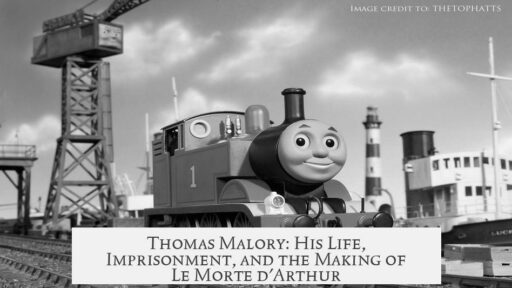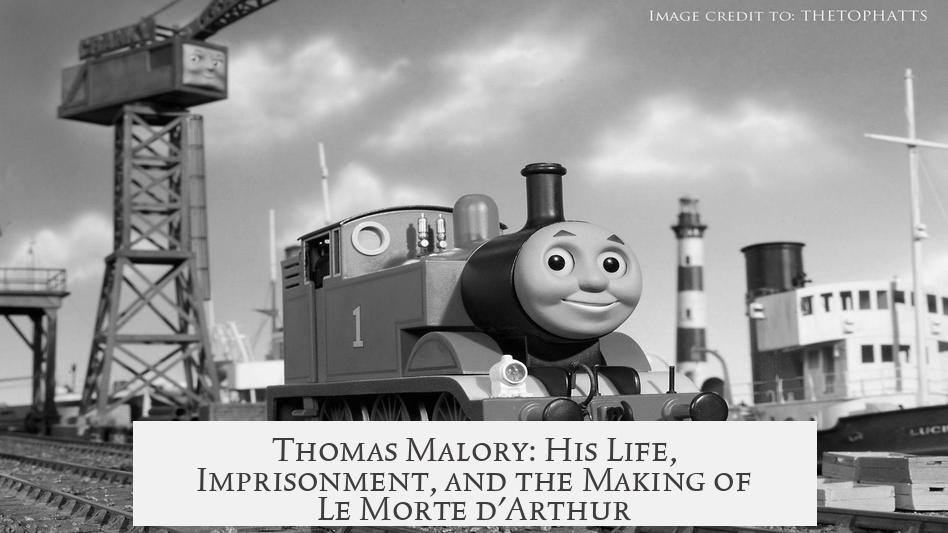Thomas Malory, likely Sir Thomas Malory of Newbold Revel, Warwickshire, is the probable author of Le Morte d’Arthur. He was a knight with a history of imprisonment and a criminal record. He wrote this work by adapting multiple sources during his time in prison.
Malory’s identity remains uncertain due to the commonality of his name in 15th-century England. Scholars mostly agree on Sir Thomas Malory of Warwickshire, born around 1415 and deceased in 1471, as the author. This choice relies on the author’s self-identification as both a knight and a prisoner.
Malory’s life involved several criminal accusations. These included theft, extortion, and assault. Notably, he faced charges for ambushing the Duke of Buckingham with an assassination attempt, indicating a turbulent existence. His imprisonments took place in multiple locations, among which Newgate Prison in London is notable.
The writing process of Le Morte d’Arthur shows Malory’s skill in combining sources. These sources ranged from French romances to English chronicles. Instead of literal translation or simple copying, Malory merged these stories to devise a unique narrative about King Arthur and his knights.
Le Morte d’Arthur divides into eight tales. Each tale explores different elements of the Arthurian saga, emphasizing chivalry, love, betrayal, and moral conflict. The text reflects a complex interplay of medieval ideals and personal creativity.
It is generally accepted that Malory composed this work during his imprisonment. This detail sheds light on his circumstances and may have influenced the tone and themes of his narratives.
- Thomas Malory’s exact identity is uncertain but most likely Sir Thomas Malory of Newbold Revel.
- He had a criminal record with several imprisonments, including in Newgate Prison.
- Le Morte d’Arthur adapts French and English source material creatively.
- The work is structured around eight distinct Arthurian tales.
- Malory probably wrote the text while in prison.
What Do We Know About Thomas Malory, His Imprisonment, and the Writing Process of Le Morte d’Arthur?

Thomas Malory, a knight appearing from the mist of 15th-century England, wrote the iconic Le Morte d’Arthur during a spell behind bars. That’s right—one of the most celebrated medieval works about King Arthur’s legends was crafted by a man with a shadowy identity, dubious criminal activities, and a knack for storytelling while doing time. So who was this Thomas Malory, and how exactly did prison inspire his literary masterpiece?
The Mystery Man Behind the Manuscript
First off, “Thomas Malory” wasn’t exactly a unique name back then. In fifteenth-century England, it belonged to quite a few men, much like “John Smith” today. Pinning down the precise author of Le Morte d’Arthur can feel like chasing a knight’s ghost through Warwickshire fields — elusive and fraught with dead ends.
The prime suspect, however, is Sir Thomas Malory of Newbold Revel in Warwickshire, born around 1415 and passing in 1471. This guy ticks many crucial boxes: knightly status and time spent in prison match the self-description found inside the text. But why do scholars focus on him? Because he fits the criminal profile laid out in historical records.
A Knight’s Not-So-Honorable Record
Sir Thomas Malory’s criminal rap sheet looks like something out of an Arthurian rogue’s gallery. He wasn’t just an amateur scoundrel; allegations include theft, extortion, assault, and even a rather dramatic ambush attempt on the Duke of Buckingham. Imagine a medieval knight moonlighting as a bandit! This colorful backstory adds a vivid human touch to the figure otherwise enshrined in literature.
His brushes with the law landed him in Newgate Prison, a notorious London dungeon not exactly known for inspiring creativity. Yet, the prison walls that confined Malory might have also sparked the imagination that birthed Le Morte d’Arthur. Locked away but free in mind, he shaped tales of chivalry and betrayal while living a life full of contradictions.
Le Morte d’Arthur’s Birth: Imprisonment as a Creative Crucible
Malory didn’t freshly invent Arthurian legends. Instead, he acted as a masterful editor and compiler. Think of him as a medieval DJ, sampling French romances, English chronicles, and his own brilliance to create a new epic mixtape. He selected, adapted, and combined his sources to craft a unique saga that remains a cornerstone of Arthurian lore.
The work itself is a hefty crowd-pleaser, divided into eight interwoven tales. Each one zeroes in on a different facet of Arthur’s realm — from tales of noble knights to tragic betrayals and quests for the Holy Grail. The themes drip with the glow of chivalry, passion, good vs. evil, and the heavy burden of loyalty.
Why Write While Imprisoned?

You might wonder how Malory found the energy and motivation to write such a sprawling work while confined. Prison isn’t exactly the library vibe one dreams of. Some speculate that the solitude offered him uninterrupted time, while the dramatic turmoil of his life fueled his fascination with moral conflicts and heroism. Perhaps he imagined his own redemption mirrored in Arthur’s court—and his own failings reflected in the knights’ tragic flaws.
It’s worth highlighting that Le Morte d’Arthur isn’t just a dry collection of knight tales. It’s a carefully structured narrative that explores the human condition through legendary figures. Malory’s experience of imprisonment might have sharpened his eye for betrayal and honor — themes central to his work.
Lessons and Legacies: Why Does This Matter Today?
Learning about Malory’s life enriches our reading experience. Knowing the writer was a flawed knight, sometimes a criminal and prisoner, gives Le Morte d’Arthur a powerful authenticity. This isn’t just romanticized myth spinning; it’s a real human grappling with ethics, love, and loyalty.
What does this mean for readers and writers today? First, inspiration can come from the most unlikely places—even prison. Second, creative work often reflects the complexities of its creator’s life. Malory’s criminal past and his literary achievements remind us that art often arises from conflict and contradiction.
If you’re fascinated by world-building or storytelling, take a page from Malory’s book—sometimes melding existing ideas with personal insight produces the richest results. Instead of just copying, innovate and weave sources into something new, much as he blended chronicles and romances into a timeless legend.
In Summary
- Identity: Thomas Malory was most likely Sir Thomas Malory of Warwickshire, a knight with a spotted past.
- Imprisonment: His time in prison, including Newgate, was a key period during which he wrote Le Morte d’Arthur.
- Writing Process: He synthesized multiple sources and his own creativity into eight tales exploring chivalry, loyalty, love, and betrayal.
- Impact: Despite his flaws and challenges, Malory produced an enduring cornerstone of Arthurian literature.
The tale of Thomas Malory himself is almost as gripping as those he wrote. A knight, a criminal, a prisoner, and a storyteller all rolled into one. And thanks to his work, the legends of King Arthur continue to inspire readers, shining a light on the timeless human struggles of honor, courage, and redemption.




